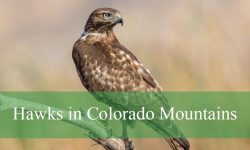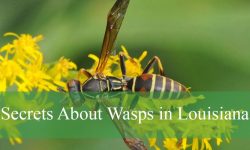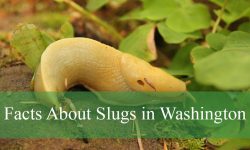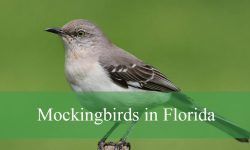Hawks in Washington are an important part of the state’s wildlife. They can be seen in many different habitats, from forests and fields to wetlands. Learning to recognize these birds is a great way to enjoy nature and understand more about the environment around you.
There are many different types of hawks in Washington, each with its own size, color, and behavior. Some, like the Red-tailed Hawk, are common and easy to spot, while others are rarer or only seen during migration. This article will introduce you to nine types of hawks you might see in Washington.
Understanding hawks in Washington can make your time outdoors more interesting. This guide includes clear photos and descriptions to help you identify these birds wherever you go in the state.
Different Types of Hawks Found in Washington
Red-tailed Hawk (Buteo jamaicensis)
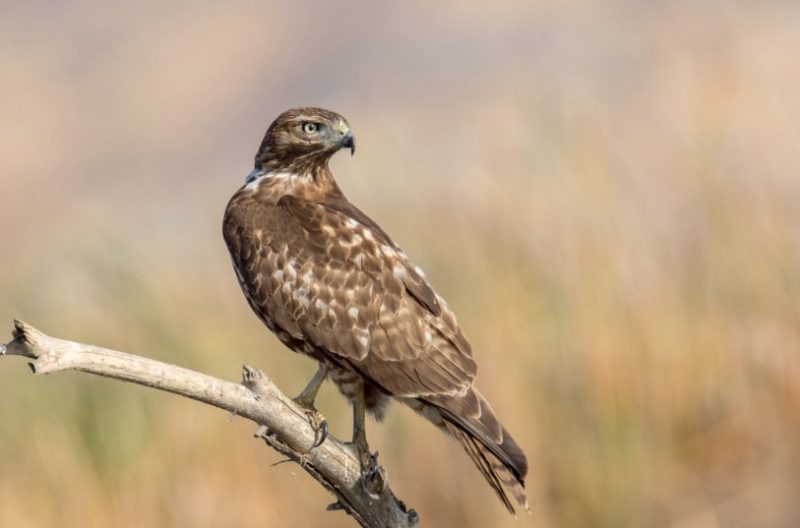
The Red-tailed Hawk is undoubtedly one of the most common and iconic raptors found across Washington state. Measuring between 18 and 26 inches in length, with a wingspan that ranges from 43 to 57 inches, this hawk is large and robust, making it one of the more noticeable birds of prey in the region. Its broad, rounded wings and short, wide tail are designed for soaring flight. The most distinctive feature is its reddish-brown tail, which is especially visible in adult birds and gives the species its name. While there is some variation in plumage, most Red-tailed Hawks have a brown back and a pale, streaked underside. Juveniles lack the red tail and instead have brown, banded tails.
Red-tailed Hawks are highly adaptable birds both in terms of habitat and diet. They thrive in a variety of environments, from rural farmland and grasslands to forest edges and even urban areas. Their diet mainly consists of small to medium-sized mammals such as rabbits, squirrels, and rodents, but they also prey on birds, reptiles, and occasionally carrion. Their hunting strategy typically involves soaring high in the sky, using their keen eyesight to spot movement on the ground before diving swiftly to catch prey. Their presence along highways and open fields makes them a familiar sight to many Washington residents.
Behaviorally, Red-tailed Hawks are known for their territorial nature, especially during the breeding season when they establish nests in tall trees or cliff ledges. They engage in spectacular aerial displays to defend their territory and attract mates. These hawks are generally solitary or found in pairs outside of migration. Their loud, distinctive “kee-eeer” call is often heard echoing across Washington’s landscapes, contributing to their recognition by birdwatchers and nature enthusiasts.
In terms of distribution, Red-tailed Hawks are year-round residents throughout Washington, from the western forests near the coast to the eastern agricultural valleys and even the mountainous regions. Their ability to adapt to different habitats and climates allows them to thrive throughout the state, making them one of the most frequently observed raptor species by local birdwatchers. Whether perched on roadside poles or soaring high overhead, the Red-tailed Hawk remains a quintessential part of Washington’s avian community.
Cooper’s Hawk (Accipiter cooperii)
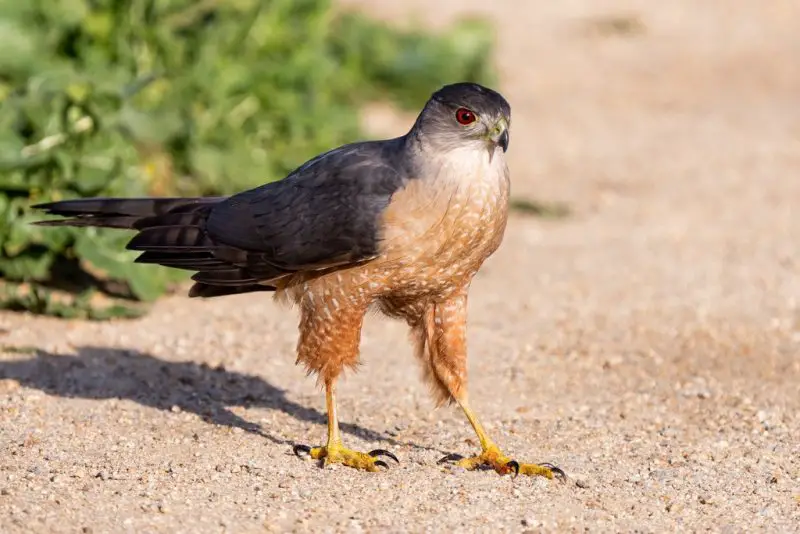
The Cooper’s Hawk is a medium-sized raptor that measures about 14 to 20 inches in length, with a wingspan between 24 and 35 inches. This hawk has a sleek, streamlined build that is well adapted for agility and speed, especially in wooded environments. Its tail is rounded with several dark bands, and its back is a smooth blue-gray color. The underparts are pale with reddish horizontal barring. Juveniles differ in having brown streaking rather than barring. The Cooper’s Hawk’s sharp, piercing eyes and hooked beak highlight its role as a skilled predator, specialized in catching birds.
In Washington, Cooper’s Hawks are most often found in forests and suburban areas where there is abundant cover for stealth hunting. Unlike broad-winged hawks that soar and circle openly, Cooper’s Hawks rely on quick bursts of speed and maneuverability to chase birds through dense tree cover or shrubbery. Their diet consists mainly of medium-sized birds like pigeons, doves, and songbirds, but they will also take small mammals on occasion. Their hunting technique often involves silently approaching prey from behind, using surprise to their advantage.
Behaviorally, Cooper’s Hawks are territorial during the breeding season and construct nests high in tall trees, usually hidden within dense foliage. They are known to be somewhat secretive outside of the breeding season but can sometimes be spotted perching quietly, watching for prey. Their flight is fast and direct, with rapid wingbeats punctuated by brief glides, which helps them navigate through the forest canopy with precision.
The distribution of Cooper’s Hawks in Washington spans both western and eastern parts of the state, where forests and suburban green spaces provide suitable habitat. They are permanent residents but may exhibit some local movement during harsh winters. Their adaptability to suburban environments also brings them into close contact with human habitation, making them a familiar yet elusive presence for birdwatchers in the state.
Sharp-shinned Hawk (Accipiter striatus)
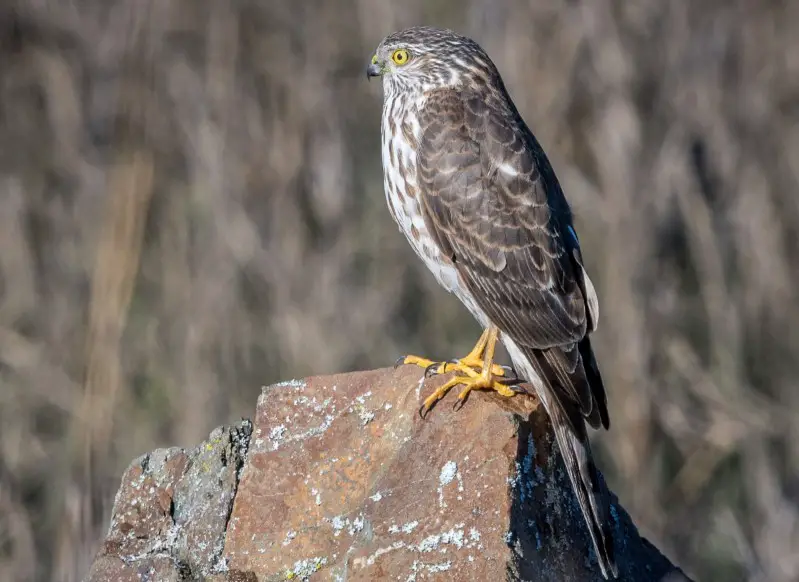
The Sharp-shinned Hawk is the smallest hawk species commonly found in Washington, measuring only 10 to 14 inches in length and having a wingspan of 20 to 27 inches. Its body is slender and agile, perfectly built for swift, maneuverable flight through dense forest and brush. This hawk is characterized by a square-tipped tail with narrow dark bands, which helps distinguish it from similar species such as the Cooper’s Hawk, whose tail is rounded. The Sharp-shinned Hawk’s upperparts are a slate gray, while the chest and belly are pale with reddish or orange barring.
This hawk’s hunting style is highly specialized, relying on surprise and speed to catch small songbirds and other avian prey in wooded habitats. It uses quick, low flights to navigate through thickets and dense foliage, often darting suddenly to snatch prey. Its small size and agility make it an effective predator in the dense forests of Washington. Because of this secretive nature and preference for thick cover, the Sharp-shinned Hawk is less commonly observed than larger hawks but is nonetheless a regular resident and migrant.
Sharp-shinned Hawks tend to be shy and elusive, often avoiding open areas and human activity. They nest high in coniferous or mixed forests, building relatively small stick nests concealed among dense branches. Their breeding range includes much of Washington, particularly forested areas, though they are also seen during migration when moving between breeding and wintering grounds.
In Washington, this species is found year-round in many forested areas, especially in the western parts of the state. Their presence is important for controlling populations of small birds, and they play a vital role in the ecological balance of their habitats. For birdwatchers, spotting a Sharp-shinned Hawk is always exciting due to its elusive nature and swift, acrobatic flight.
Northern Harrier (Circus hudsonius)
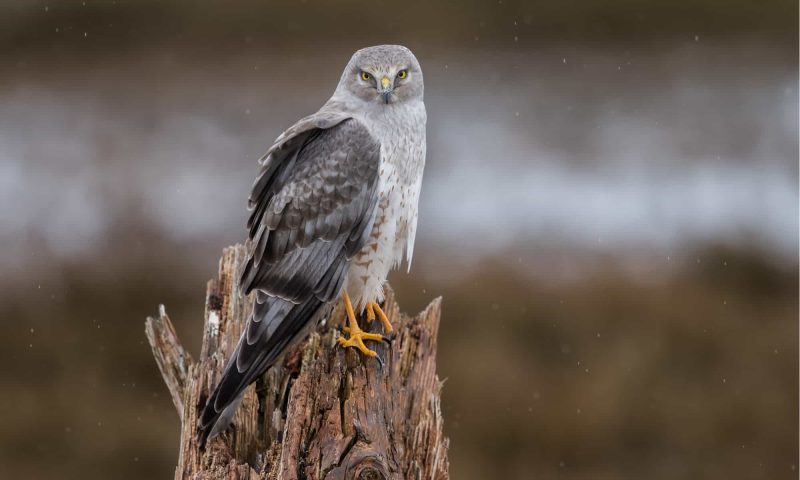
The Northern Harrier is a distinctive hawk easily identified by its unique hunting behavior and physical features. Measuring around 18 to 22 inches in length with a wingspan of 40 to 46 inches, it is medium-sized but slender and built for low, slow flight over open terrain. One of its most notable characteristics is the owl-like facial disk, which enhances its hearing and helps detect prey hidden in dense vegetation. Another striking feature is the bright white patch on the rump, visible during flight and often used as a key identification marker. Males tend to have grayish plumage, while females and juveniles show more brown coloring.
This species favors wetlands, marshes, grasslands, and open fields in Washington, where it hunts by flying low over the ground, using both sight and sound to locate small mammals, birds, and amphibians. Northern Harriers have a slow, buoyant flight pattern with wings held in a shallow V-shape, allowing them to glide close to the vegetation below. This methodical hunting style contrasts with the high-soaring behavior of many other hawks.
Northern Harriers are generally solitary but may be found in small groups during migration. They build nests on the ground, often concealed in tall grasses or marsh vegetation, making their breeding sites vulnerable to disturbance. These hawks are year-round residents in parts of Washington but may be more numerous in the winter when birds from colder regions migrate south.
In terms of distribution, the Northern Harrier is widely spread across Washington’s wetlands and open landscapes, particularly in the Puget Sound area and the eastern plains. Their presence is a valuable indicator of healthy wetland ecosystems, and they are a favorite among birdwatchers for their distinctive flight and hunting behavior.
Broad-winged Hawk (Buteo platypterus)
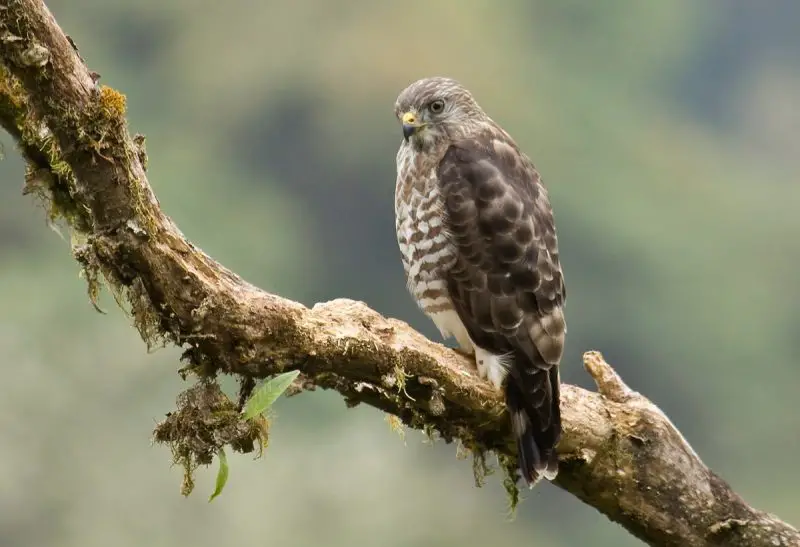
The Broad-winged Hawk is a smaller buteo raptor measuring about 14 to 18 inches long with a wingspan ranging from 34 to 39 inches. This hawk is known for its broad wings and a tail with several dark bands, which are useful field marks. The plumage is generally brown on the back, with white and brown streaked underparts. Their strong, rounded wings make them adept at soaring, which is especially important during migration. Juveniles and adults look similar, but juveniles tend to have paler, more mottled plumage.
Broad-winged Hawks are mostly seen in Washington during their spring and fall migrations, traveling between northern breeding grounds in Canada and the northeastern U.S. and their wintering areas in Central and South America. They often migrate in large groups called “kettles,” where hundreds or even thousands of hawks soar together on thermal updrafts, creating spectacular displays visible to birdwatchers. Outside migration periods, they prefer forested habitats for breeding.
In Washington, Broad-winged Hawks are uncommon as year-round residents but can be observed soaring over forested areas, especially during migration seasons. Their presence in the state is most notable at vantage points along migration routes where thermals and ridges help the birds gain altitude. These hawks prefer deciduous and mixed forests for nesting and typically hunt small mammals, reptiles, and insects.
Their impressive migration behavior and tendency to form large soaring groups make Broad-winged Hawks an exciting species to observe in Washington. Birdwatchers often look forward to migration seasons when these hawks pass through the state in large numbers.
Ferruginous Hawk (Buteo regalis)
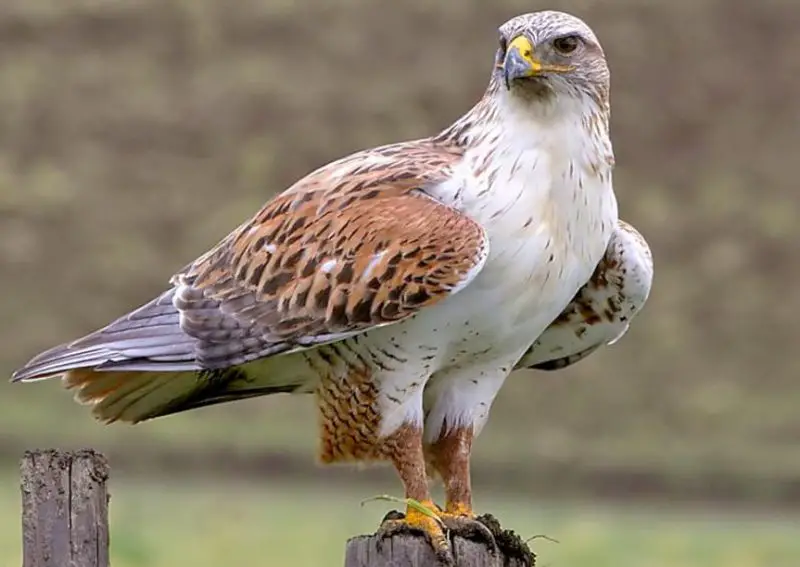
The Ferruginous Hawk is one of the largest hawks found in North America, measuring between 22 and 27 inches in length and boasting a wingspan of 50 to 60 inches. This species is easily recognized by its striking rusty or ferruginous coloration on the back and shoulders, contrasting with a pale underbelly. The bird’s strong, broad wings and powerful build allow it to soar with ease over open landscapes. Unlike other buteos, Ferruginous Hawks lack the dark wing tips seen in many related species, giving them a more uniform appearance.
In Washington, the Ferruginous Hawk is less common than other hawks and is primarily found in the eastern part of the state, where open grasslands and shrub-steppe habitats prevail. These hawks hunt a diet dominated by mammals, especially ground squirrels, rabbits, and prairie dogs, using soaring flight and keen eyesight to locate prey from great heights. Their hunting style involves circling slowly and then diving sharply to capture their quarry.
Ferruginous Hawks are generally solitary or found in pairs and establish nests on cliffs, trees, or even abandoned nests of other large birds. They are considered a species of conservation concern in parts of their range due to habitat loss and fragmentation. In Washington, their presence is a sign of healthy open rangeland ecosystems, where their role as apex predators helps maintain balance.
Because of their rarity and impressive size, Ferruginous Hawks attract significant attention from birdwatchers and conservationists in Washington. Spotting one can be a highlight of a birding trip, particularly in the wide-open spaces of the eastern plains.
Swainson’s Hawk (Buteo swainsoni)
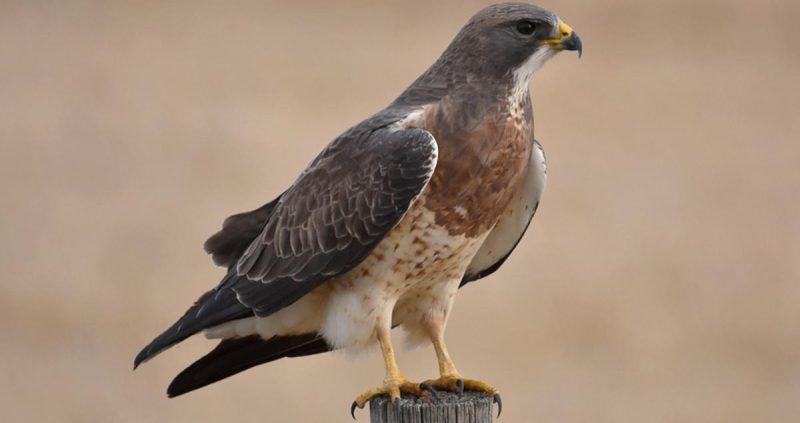
Swainson’s Hawk is a long-distance migratory raptor that passes through Washington during its spring and fall migrations. It breeds primarily in the northern plains and western Canada, then travels thousands of miles to spend the winter in South America, particularly in Argentina and other regions of the pampas. This impressive migration is one of the longest among North American hawks, and large groups of Swainson’s Hawks can be seen soaring together in formations called “kettles” during migration periods, making for spectacular birdwatching events.
In terms of appearance, the Swainson’s Hawk has a slender build compared to other buteos, with relatively narrow wings and a long tail. Its plumage is generally a light brown on the upperparts with a pale, creamy belly, often marked with streaks or spots. Some individuals may have darker morphs. Their wings show a distinctive pattern with darker flight feathers contrasting against lighter underwings, which can help with identification during flight. Their long, pointed wings aid in their soaring migration flight.
Behaviorally, Swainson’s Hawks spend much of the year on the wing during migration and breeding seasons. They are highly social during migration, often forming large groups that ride thermal currents to conserve energy. When not migrating, they are solitary or found in pairs, nesting on open prairies, grasslands, or agricultural fields. Their diet during the breeding season consists mainly of small mammals and insects, but during migration and wintering periods, they shift to feeding heavily on grasshoppers and other large insects.
In Washington, Swainson’s Hawks are primarily seen during their migratory journeys, soaring over open landscapes and river valleys. Although they do not commonly breed in the state, they occasionally stop to rest or hunt while on migration. Their presence is often an exciting sign of seasonal change, and birdwatchers eagerly anticipate the swarms of these hawks passing through in spring and fall.
Rough-legged Hawk (Buteo lagopus)
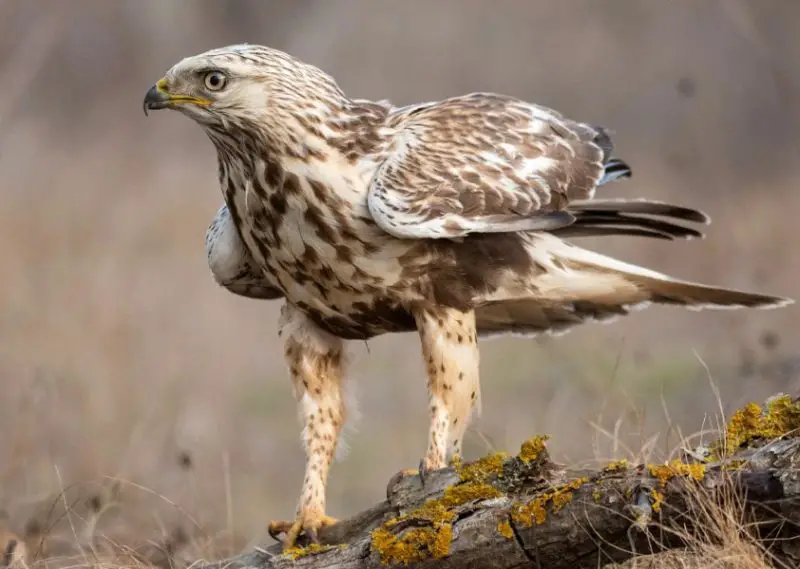
The Rough-legged Hawk is a winter visitor to Washington, migrating south from its Arctic breeding grounds to escape the harsh polar winter. This medium-large hawk measures between 19 and 24 inches in length, with a wingspan of about 52 to 60 inches, making it one of the larger buteos seen in the state during winter months. Its name derives from the feathered “rough” legs, which extend down to the toes, providing insulation against cold temperatures—a unique adaptation among hawks.
Rough-legged Hawks have striking plumage, typically dark brown on the upperparts with heavily spotted white patches on the wings. Their belly and chest are light-colored with varying amounts of dark streaking. One of the key identifying marks is the white patch near the base of the tail, visible when the bird is in flight. They exhibit two color morphs: a dark morph with more uniform dark feathers and a light morph with paler coloration. This variation helps them blend into the snowy and open tundra-like environments where they breed and hunt.
In terms of behavior, these hawks hunt primarily in open fields and grasslands, flying low over the ground while searching for small mammals such as voles and lemmings, which make up the bulk of their diet. They also prey on birds and occasionally carrion. Their slow, buoyant flight and ability to hover briefly in the air while searching for prey are distinctive. Rough-legged Hawks are generally solitary or found in loose groups during winter.
In Washington, Rough-legged Hawks are most commonly found in the eastern lowlands and open agricultural areas during winter months. Their presence is a reliable indicator of cold weather and open habitat health, as they require large expanses of grassland or farmland for hunting. Though not permanent residents, these hawks bring a wild Arctic connection to Washington’s winter birdlife.
Gray Hawk (Buteo plagiatus)
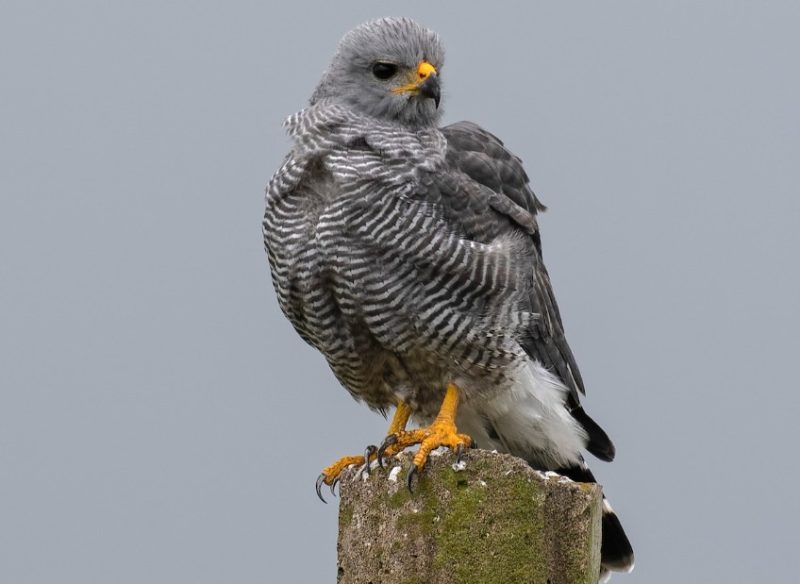
The Gray Hawk is a less common but notable species in Washington, usually seen as a rare migrant or an occasional visitor during warmer years. This medium-sized hawk measures roughly 17 to 20 inches long with a wingspan around 42 to 46 inches. It is characterized by its uniform gray plumage, with subtle barring on the tail and lighter underparts. The gray coloration makes it distinct from many other buteo hawks in the region and allows for relatively easy identification when spotted.
Gray Hawks are native to more southern parts of North America, including Mexico, the southwestern U.S., and parts of Central America. They prefer habitats near water, such as riparian forests, woodlands, and areas with dense tree cover close to streams or rivers. Their diet consists primarily of reptiles, amphibians, small mammals, and birds. They are known for being skilled hunters, often perching quietly and waiting patiently before launching a quick, targeted strike.
In Washington, Gray Hawks are very rare and typically appear during migration periods or as vagrants during unusually warm seasons. When they do occur, they are most often found in forested areas along rivers or near wetland habitats, where the environment more closely resembles their preferred southern range. Because of their rarity, sightings are often considered special by local birdwatchers and may attract significant interest.
Overall, the Gray Hawk’s presence in Washington highlights the dynamic and occasionally unpredictable nature of bird migration and distribution. Its sightings provide valuable data about changing climate patterns and habitat shifts, making it an intriguing species for ornithologists and enthusiasts alike.

